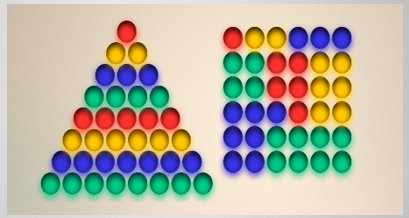We'll be back in a bit !
The system is currently undergoing a routine upgrade to ensure you get the best learning experience. The maintenance is expected to continue till 8:00 pm. Please check back later.
Thank you for your understanding!

Patterns of square numbers are some set of rules in which the square of numbers are arranged. We often come across various puzzles and activities where we have been given a certain clue about some objects and with the help of this clue, we have to find the missing object.
As an illustration, the following series is provided: 2, 4, 6, 8, 10,__. In this instance, we need to track down the sixth missed item. So, it is clear that the even numbers in the provided series are organized in ascending order. The following even number, 12, will therefore be the sixth term in the series.
Mathematicians refer to an arrangement of numbers that follows a specific design as a pattern.
The square numbers are organized in various designs when we refer to square number patterns. The series of square integers, for instance, is 1, 4, 9, 16, and 25 organized in ascending order.
The outcome of the product of two similar numbers is known as square numbers.
For example,
9x9=81 i.e., 81 is a square number.
3x3=9 i.e., 81 is a square number.
There are numerous square number patterns in mathematics that are extremely interesting to understand. Due to the fact that they cover a square's surface, square numbers are also known as cubed numbers. The edges form a square because they are all the same measurement in units. Here are a few of them:
Sum of odd natural numbers
The sum of first ‘n’ odd numbers could be equal to the square of that particular number
n. For example,
The Sum of the first 6 odd numbers = 1+3+5+7+9+11=62 =36
The Sum of the first 7 odd numbers=1+3+5+7+9+11+13=72 =49
Difference between square numbers
The difference between two successive square numbers must be an odd number. In
general, we can write, (n+1)2-n2=2n+1
For example,
Let n=3
(n+1)2-n2=2n+1
42-32 = 16 - 9 = 7 = 2 x 3 + 1
Addition of triangular numbers
Triangular numbers are those that are created by adding natural numbers continuously. Like the series of triangular numerals, 1, 3, 6, 10, 15, and 21.
The sum of any two consecutive triangle integers is now always a square number.
For instance,
3+6=9=32
15+21=36=62
Numbers between square numbers
There are in total 2n non-perfect square numbers between two successive square numbers n2 and (n+1)2.
For example, if we take n= 8 then two successive square numbers are 82 = 64 and 92=81.
Therefore between 64 and 81 there are 28 non-square numbers which are equal to 16.
Product of two consecutive even or odd natural numbers
To express the product of two consecutive even or odd natural numbers in the terms of square numbers.
In general, we have (a+1)(a-1)=a2-1
17 x 19=323=(18)2-1=(18-1)(18+1)
Numbers having one as all the digits
The square of natural numbers which have 1 in place of their all digits follow the
following pattern:
When using this method to square numbers with only one character, we tally the digits on the number that needs to be squared. Next, write each natural number one at a time until you attain that number. Start writing backwards from that number to 1 after that.
Some Interesting Facts
If a perfect square ends with 1, its roots will end with 1 or 9.
Example: 841=292
If a perfect square ends with 6, its roots will end with 6
Example: 2116 = 462
If a perfect square ends with 5, its roots will end with 5
Example: 5625=752
Square of an odd number is always an odd number.
Square of an even number is always an even number.
1. How many numbers are there between 289 and 324? Do it without doing the direct calculation.
Ans: As 441 can be written as 289= 17 x 17 = 172
Similarly, 484 can be written as 324 = 18 x 18 = (17+1)2
Since we know that there are 2n non-perfect square numbers between
n2 and (n+1)2.
So here we will put n=17, then the number of non-square numbers will be,
2n = 2 x 17 = 34
2. Find the Square of 1111111.
Ans: 1111111 has seven digits so we have to write in ascending order from one to seven and after that in descending order up to one
1234567654321
Therefore (1111111)=1234567654321
3. How many no-squares numbers are there between 100 and 121?
Ans: 210=20
There are in total 2n non-perfect square numbers between two successive square numbers n2 and (n+1)2
In mathematics, square integers can be arranged in many different ways. Like the product of two sequential numbers with one as the first integer, the sum of odd natural numbers, the difference between square numbers, the sum of natural numbers, the addition of triangular numbers, the number between square numbers, and more.
Frequently Asked Questions
1. What does the numerical pattern indicate?
The patterns in which a collection of numbers follows a specific order are known as number patterns in mathematics. In general, patterns show how two integers relate to one another. It is also referred to as numerical series patterns.
2. What do you name a special sequence?
A special series is one that has a distinctive structure to it. A triangular series is a set of integers that can be used to create a triangle. It follows a numbering scheme that starts with 1, 3, 6, 10, etc.
3. What is the sum of the first 10 odd numbers?
Ans: 100 ( The sum of the first ‘n’ odd numbers could be equal to the square of that particular number)
